Self-Assessed Exercises: Superannuation and SMSF Workbook for Monarch
VerifiedAdded on 2020/03/02
|45
|4842
|475
Homework Assignment
AI Summary
This workbook presents a series of self-assessed exercises designed to enhance understanding of key superannuation and SMSF concepts. It covers a range of topics including contribution types (Superannuation Guarantee, salary sacrifice, etc.), contribution caps, and eligibility criteria. Exercises involve matching contribution types, applying cap limits to various scenarios, determining eligibility to contribute, calculating superannuation guarantee and government co-contributions, and calculating tax rebates for spouse contributions. Furthermore, it delves into salary sacrifice calculations, earnings tax, franking credits, conditions of release, benefit components, and withdrawal tax implications. The workbook includes detailed calculations and scenarios to illustrate practical applications of superannuation rules and regulations, and also incorporates SMSF specific topics. The solution is provided for self-assessment.
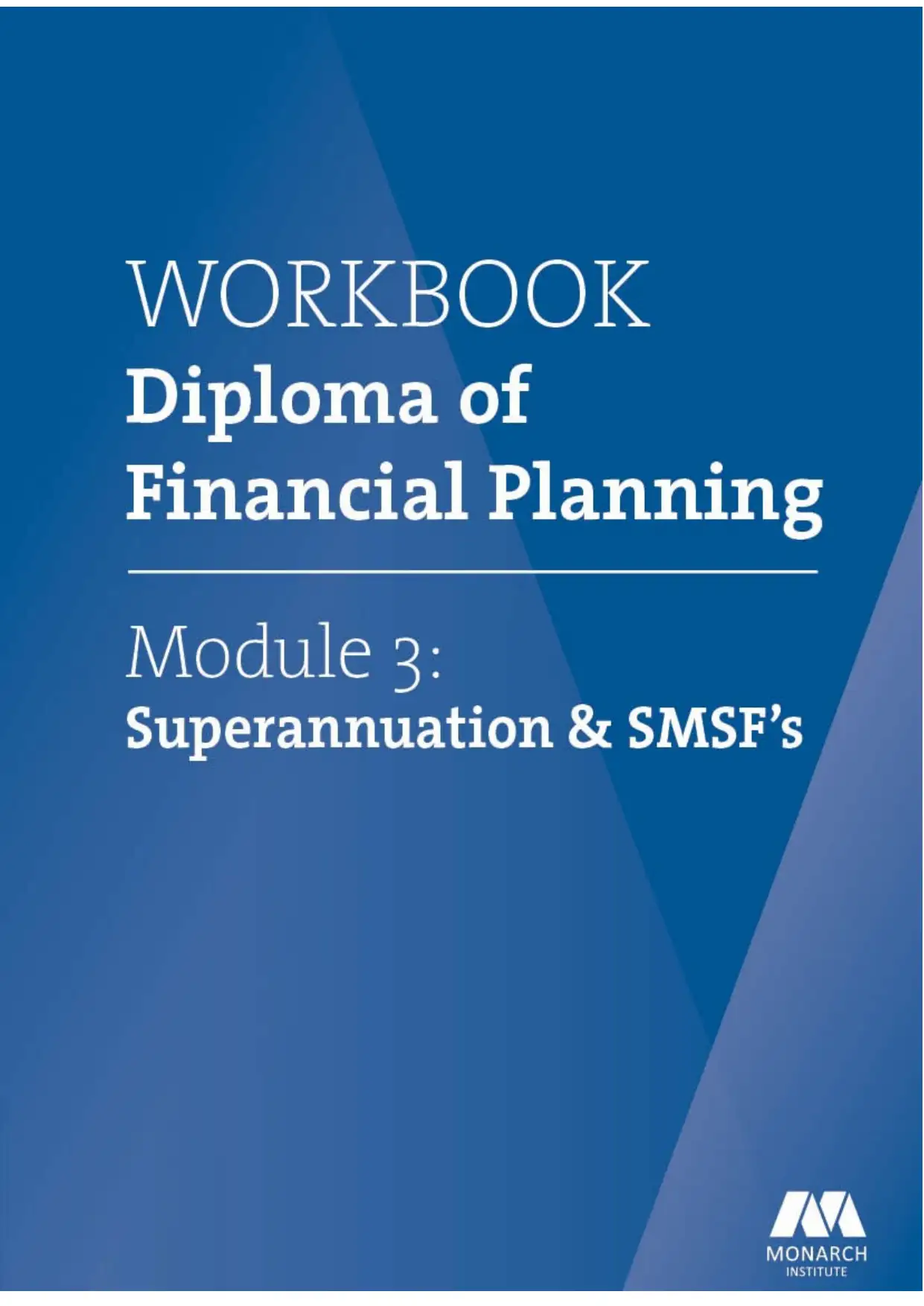
Paraphrase This Document
Need a fresh take? Get an instant paraphrase of this document with our AI Paraphraser
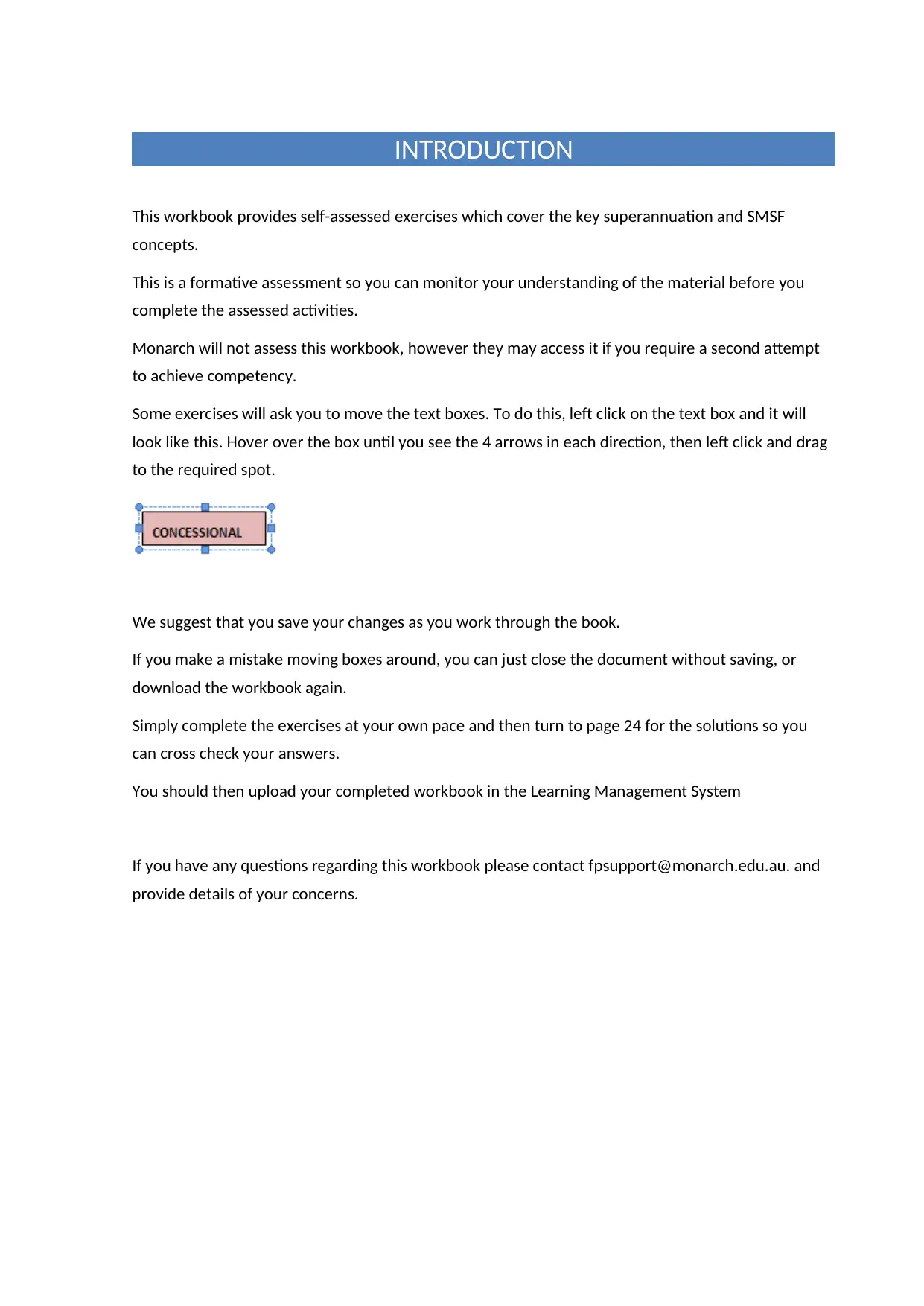
INTRODUCTION
This workbook provides self-assessed exercises which cover the key superannuation and SMSF
concepts.
This is a formative assessment so you can monitor your understanding of the material before you
complete the assessed activities.
Monarch will not assess this workbook, however they may access it if you require a second attempt
to achieve competency.
Some exercises will ask you to move the text boxes. To do this, left click on the text box and it will
look like this. Hover over the box until you see the 4 arrows in each direction, then left click and drag
to the required spot.
We suggest that you save your changes as you work through the book.
If you make a mistake moving boxes around, you can just close the document without saving, or
download the workbook again.
Simply complete the exercises at your own pace and then turn to page 24 for the solutions so you
can cross check your answers.
You should then upload your completed workbook in the Learning Management System
If you have any questions regarding this workbook please contact fpsupport@monarch.edu.au. and
provide details of your concerns.
This workbook provides self-assessed exercises which cover the key superannuation and SMSF
concepts.
This is a formative assessment so you can monitor your understanding of the material before you
complete the assessed activities.
Monarch will not assess this workbook, however they may access it if you require a second attempt
to achieve competency.
Some exercises will ask you to move the text boxes. To do this, left click on the text box and it will
look like this. Hover over the box until you see the 4 arrows in each direction, then left click and drag
to the required spot.
We suggest that you save your changes as you work through the book.
If you make a mistake moving boxes around, you can just close the document without saving, or
download the workbook again.
Simply complete the exercises at your own pace and then turn to page 24 for the solutions so you
can cross check your answers.
You should then upload your completed workbook in the Learning Management System
If you have any questions regarding this workbook please contact fpsupport@monarch.edu.au. and
provide details of your concerns.
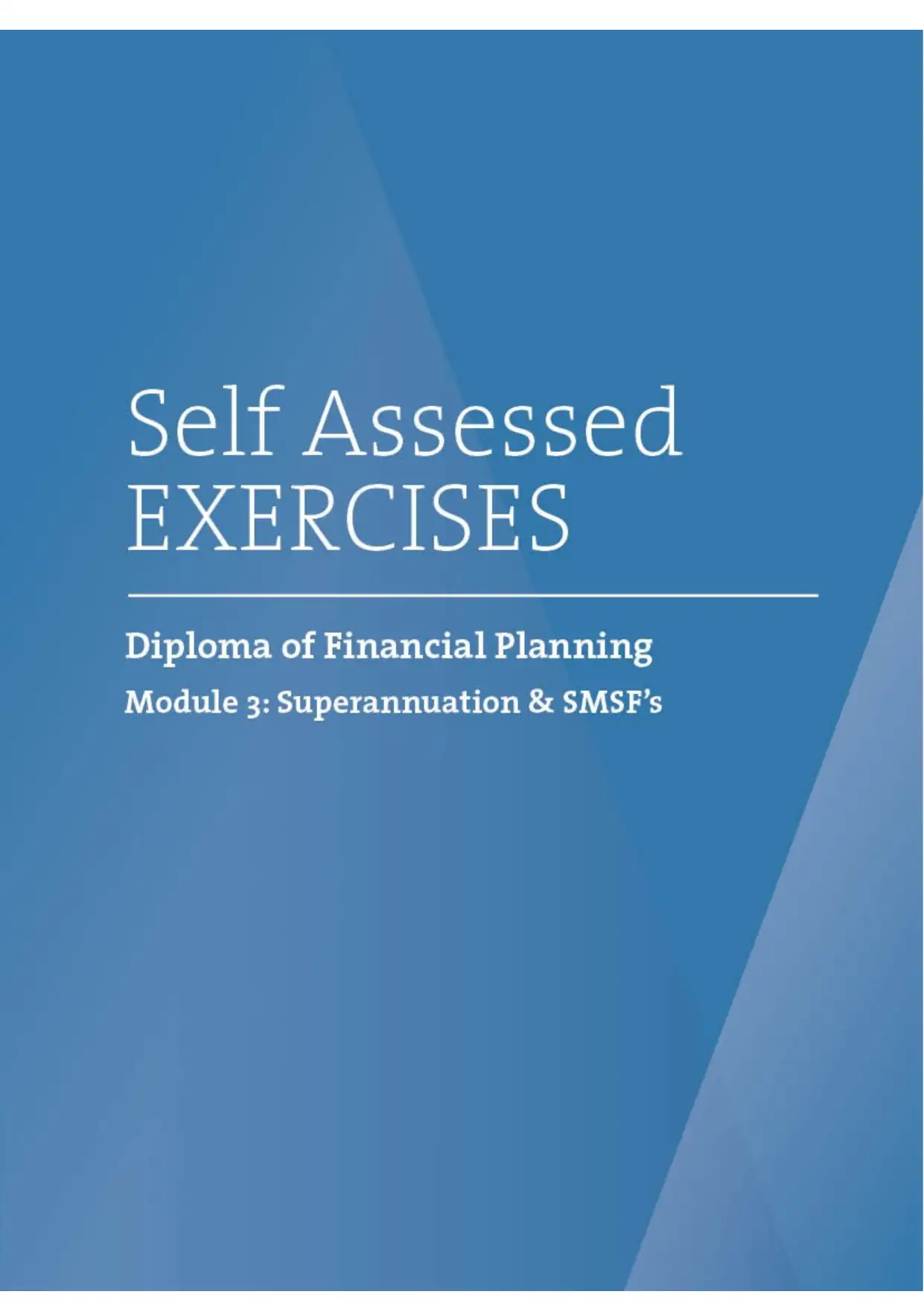
⊘ This is a preview!⊘
Do you want full access?
Subscribe today to unlock all pages.

Trusted by 1+ million students worldwide
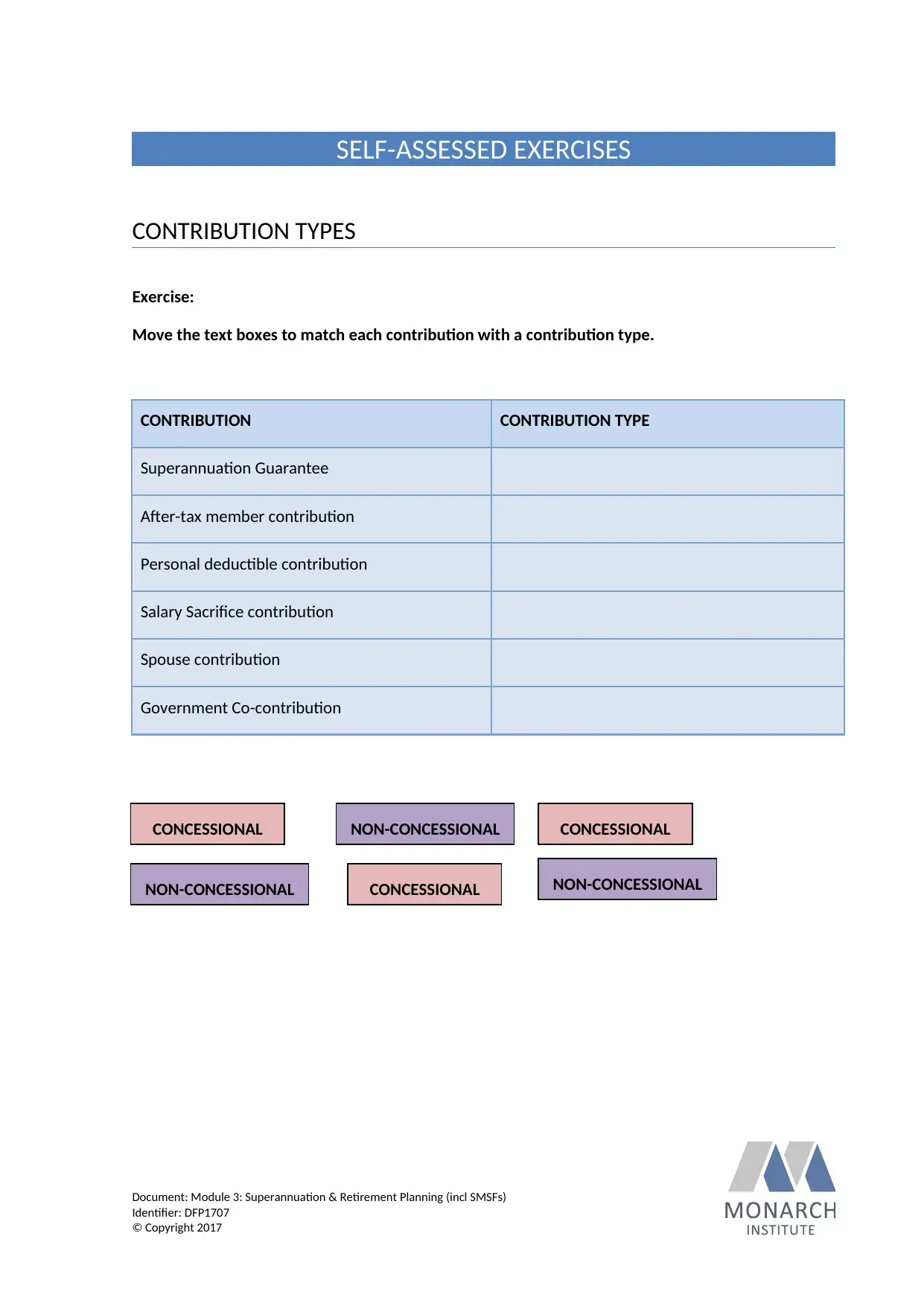
SELF-ASSESSED EXERCISES
CONTRIBUTION TYPES
Exercise:
Move the text boxes to match each contribution with a contribution type.
CONTRIBUTION CONTRIBUTION TYPE
Superannuation Guarantee
After-tax member contribution
Personal deductible contribution
Salary Sacrifice contribution
Spouse contribution
Government Co-contribution
Document: Module 3: Superannuation & Retirement Planning (incl SMSFs)
Identifier: DFP1707
© Copyright 2017
CONCESSIONAL NON-CONCESSIONAL CONCESSIONAL
CONCESSIONALNON-CONCESSIONAL NON-CONCESSIONAL
CONTRIBUTION TYPES
Exercise:
Move the text boxes to match each contribution with a contribution type.
CONTRIBUTION CONTRIBUTION TYPE
Superannuation Guarantee
After-tax member contribution
Personal deductible contribution
Salary Sacrifice contribution
Spouse contribution
Government Co-contribution
Document: Module 3: Superannuation & Retirement Planning (incl SMSFs)
Identifier: DFP1707
© Copyright 2017
CONCESSIONAL NON-CONCESSIONAL CONCESSIONAL
CONCESSIONALNON-CONCESSIONAL NON-CONCESSIONAL
Paraphrase This Document
Need a fresh take? Get an instant paraphrase of this document with our AI Paraphraser
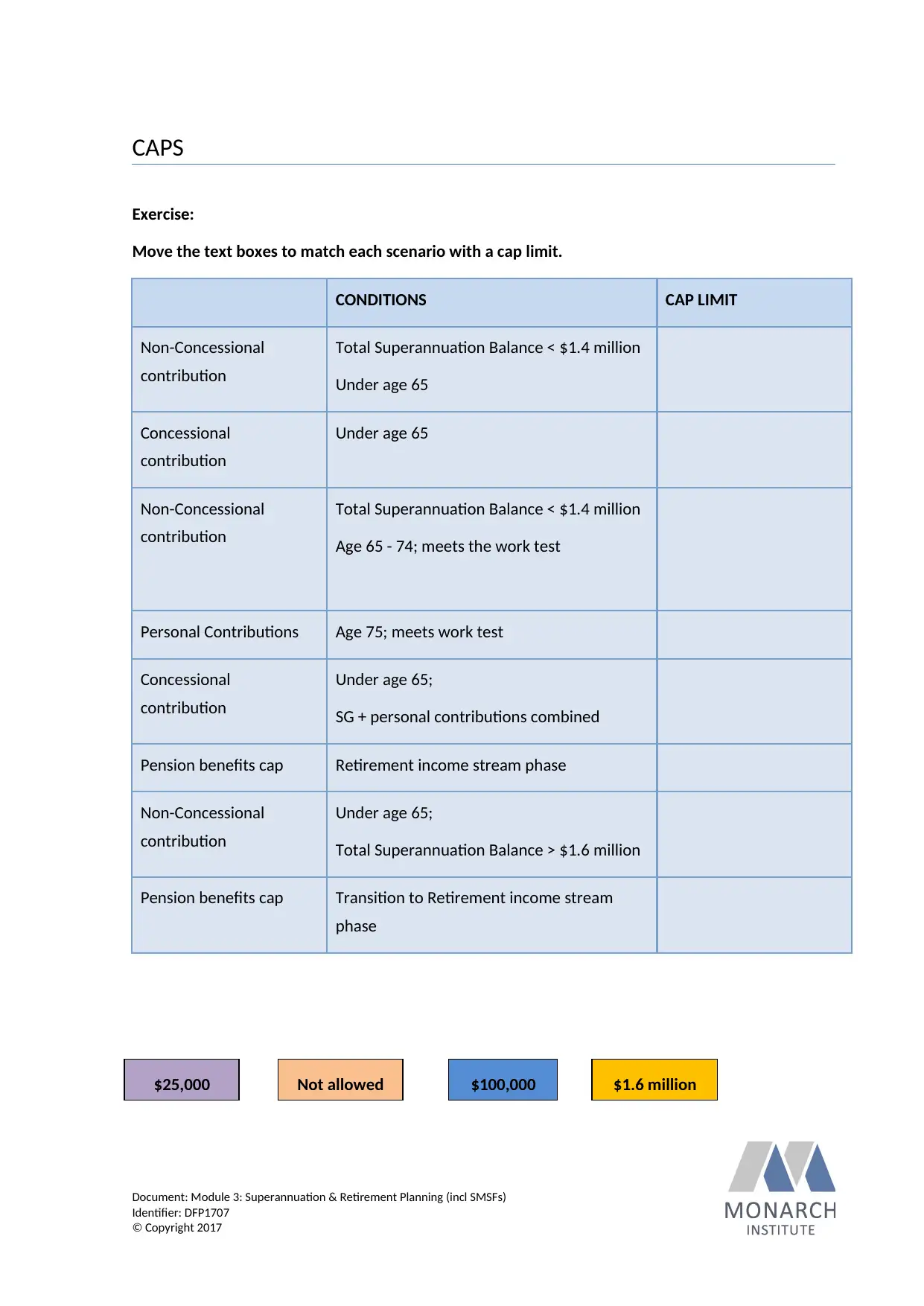
CAPS
Exercise:
Move the text boxes to match each scenario with a cap limit.
CONDITIONS CAP LIMIT
Non-Concessional
contribution
Total Superannuation Balance < $1.4 million
Under age 65
Concessional
contribution
Under age 65
Non-Concessional
contribution
Total Superannuation Balance < $1.4 million
Age 65 - 74; meets the work test
Personal Contributions Age 75; meets work test
Concessional
contribution
Under age 65;
SG + personal contributions combined
Pension benefits cap Retirement income stream phase
Non-Concessional
contribution
Under age 65;
Total Superannuation Balance > $1.6 million
Pension benefits cap Transition to Retirement income stream
phase
Document: Module 3: Superannuation & Retirement Planning (incl SMSFs)
Identifier: DFP1707
© Copyright 2017
$100,000Not allowed$25,000 $1.6 million
Exercise:
Move the text boxes to match each scenario with a cap limit.
CONDITIONS CAP LIMIT
Non-Concessional
contribution
Total Superannuation Balance < $1.4 million
Under age 65
Concessional
contribution
Under age 65
Non-Concessional
contribution
Total Superannuation Balance < $1.4 million
Age 65 - 74; meets the work test
Personal Contributions Age 75; meets work test
Concessional
contribution
Under age 65;
SG + personal contributions combined
Pension benefits cap Retirement income stream phase
Non-Concessional
contribution
Under age 65;
Total Superannuation Balance > $1.6 million
Pension benefits cap Transition to Retirement income stream
phase
Document: Module 3: Superannuation & Retirement Planning (incl SMSFs)
Identifier: DFP1707
© Copyright 2017
$100,000Not allowed$25,000 $1.6 million
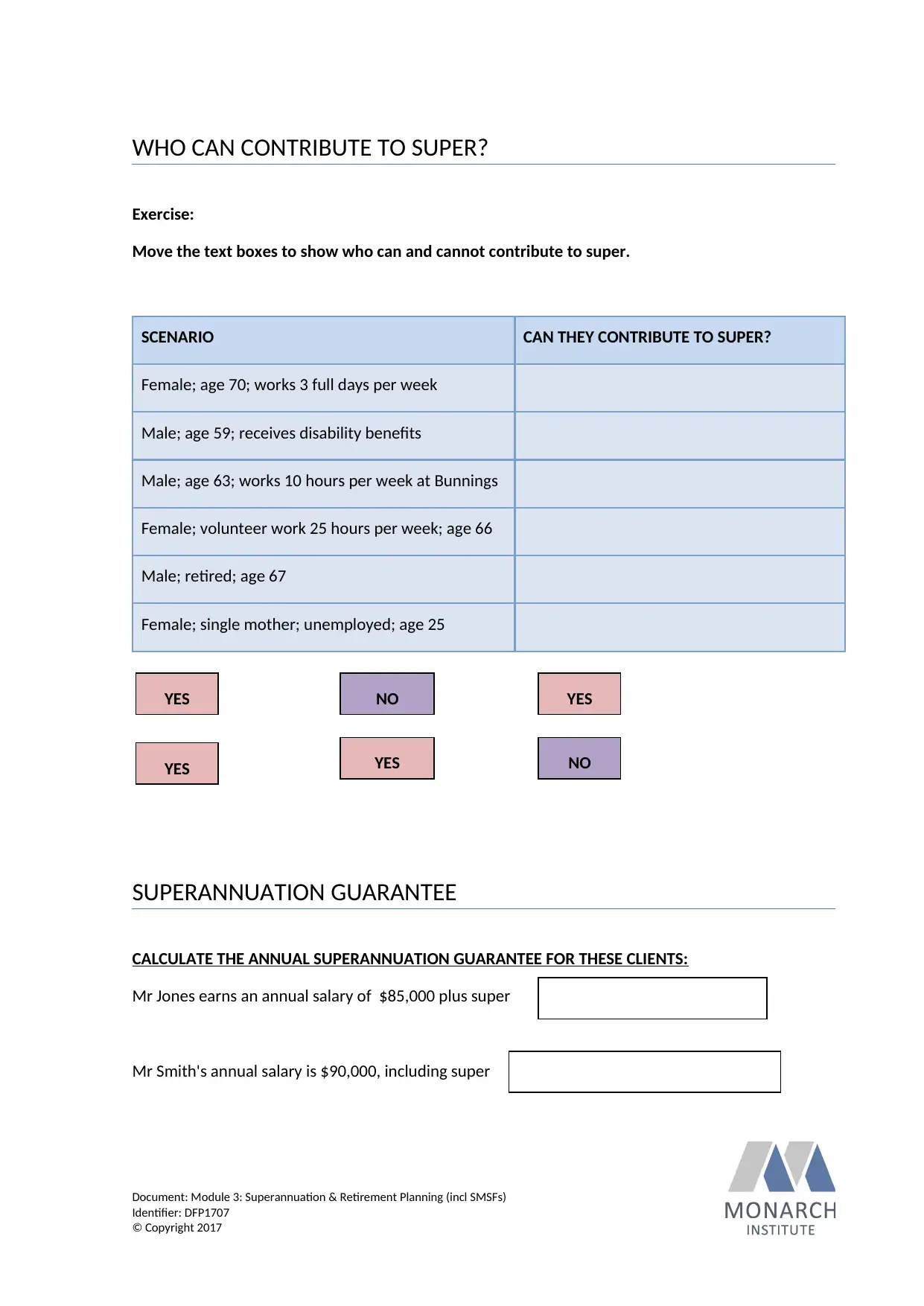
WHO CAN CONTRIBUTE TO SUPER?
Exercise:
Move the text boxes to show who can and cannot contribute to super.
SCENARIO CAN THEY CONTRIBUTE TO SUPER?
Female; age 70; works 3 full days per week
Male; age 59; receives disability benefits
Male; age 63; works 10 hours per week at Bunnings
Female; volunteer work 25 hours per week; age 66
Male; retired; age 67
Female; single mother; unemployed; age 25
SUPERANNUATION GUARANTEE
CALCULATE THE ANNUAL SUPERANNUATION GUARANTEE FOR THESE CLIENTS:
Mr Jones earns an annual salary of $85,000 plus super
Mr Smith's annual salary is $90,000, including super
Document: Module 3: Superannuation & Retirement Planning (incl SMSFs)
Identifier: DFP1707
© Copyright 2017
YES YES
YES
NO
NOYES
Exercise:
Move the text boxes to show who can and cannot contribute to super.
SCENARIO CAN THEY CONTRIBUTE TO SUPER?
Female; age 70; works 3 full days per week
Male; age 59; receives disability benefits
Male; age 63; works 10 hours per week at Bunnings
Female; volunteer work 25 hours per week; age 66
Male; retired; age 67
Female; single mother; unemployed; age 25
SUPERANNUATION GUARANTEE
CALCULATE THE ANNUAL SUPERANNUATION GUARANTEE FOR THESE CLIENTS:
Mr Jones earns an annual salary of $85,000 plus super
Mr Smith's annual salary is $90,000, including super
Document: Module 3: Superannuation & Retirement Planning (incl SMSFs)
Identifier: DFP1707
© Copyright 2017
YES YES
YES
NO
NOYES
⊘ This is a preview!⊘
Do you want full access?
Subscribe today to unlock all pages.

Trusted by 1+ million students worldwide
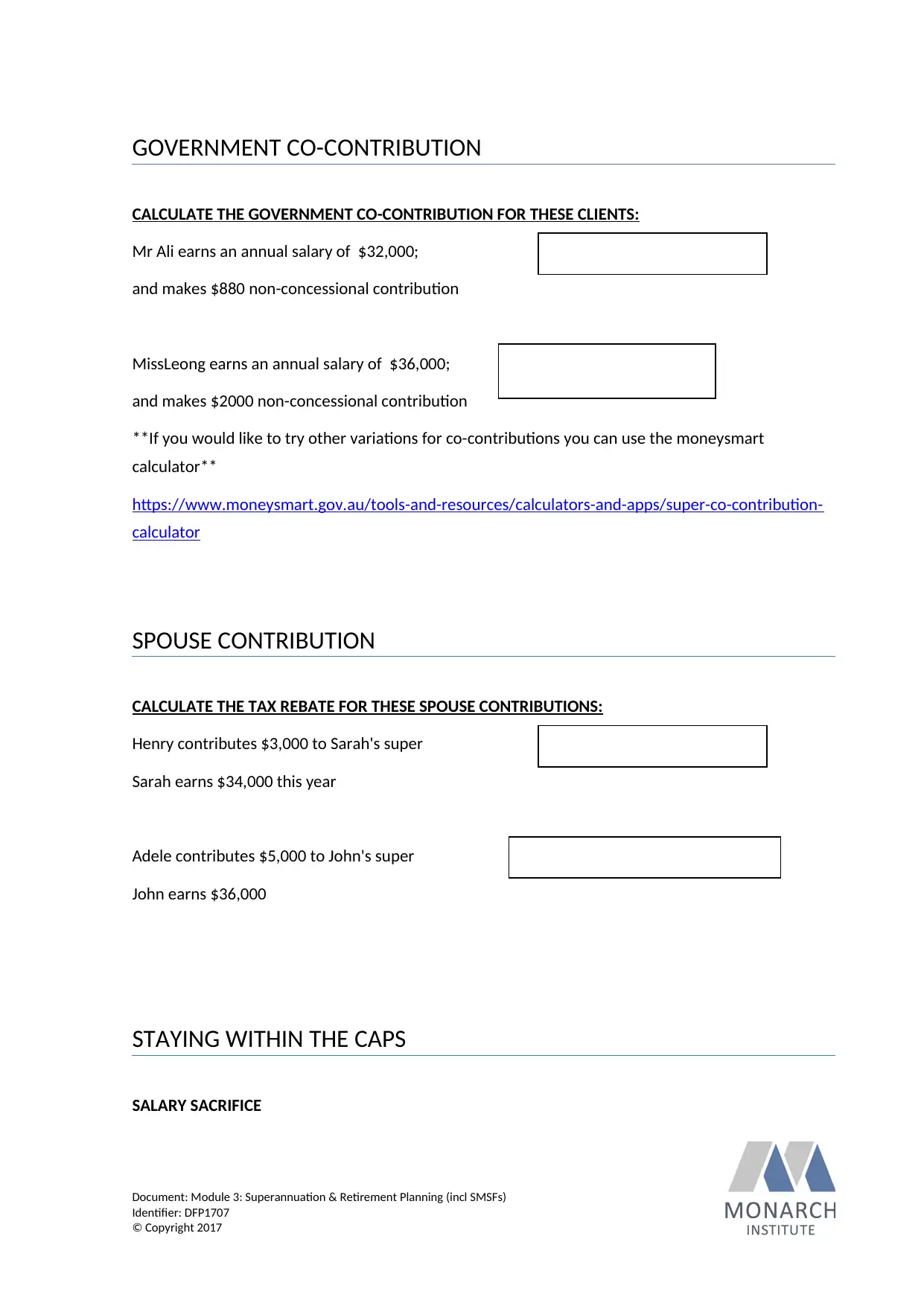
GOVERNMENT CO-CONTRIBUTION
CALCULATE THE GOVERNMENT CO-CONTRIBUTION FOR THESE CLIENTS:
Mr Ali earns an annual salary of $32,000;
and makes $880 non-concessional contribution
MissLeong earns an annual salary of $36,000;
and makes $2000 non-concessional contribution
**If you would like to try other variations for co-contributions you can use the moneysmart
calculator**
https://www.moneysmart.gov.au/tools-and-resources/calculators-and-apps/super-co-contribution-
calculator
SPOUSE CONTRIBUTION
CALCULATE THE TAX REBATE FOR THESE SPOUSE CONTRIBUTIONS:
Henry contributes $3,000 to Sarah's super
Sarah earns $34,000 this year
Adele contributes $5,000 to John's super
John earns $36,000
STAYING WITHIN THE CAPS
SALARY SACRIFICE
Document: Module 3: Superannuation & Retirement Planning (incl SMSFs)
Identifier: DFP1707
© Copyright 2017
CALCULATE THE GOVERNMENT CO-CONTRIBUTION FOR THESE CLIENTS:
Mr Ali earns an annual salary of $32,000;
and makes $880 non-concessional contribution
MissLeong earns an annual salary of $36,000;
and makes $2000 non-concessional contribution
**If you would like to try other variations for co-contributions you can use the moneysmart
calculator**
https://www.moneysmart.gov.au/tools-and-resources/calculators-and-apps/super-co-contribution-
calculator
SPOUSE CONTRIBUTION
CALCULATE THE TAX REBATE FOR THESE SPOUSE CONTRIBUTIONS:
Henry contributes $3,000 to Sarah's super
Sarah earns $34,000 this year
Adele contributes $5,000 to John's super
John earns $36,000
STAYING WITHIN THE CAPS
SALARY SACRIFICE
Document: Module 3: Superannuation & Retirement Planning (incl SMSFs)
Identifier: DFP1707
© Copyright 2017
Paraphrase This Document
Need a fresh take? Get an instant paraphrase of this document with our AI Paraphraser
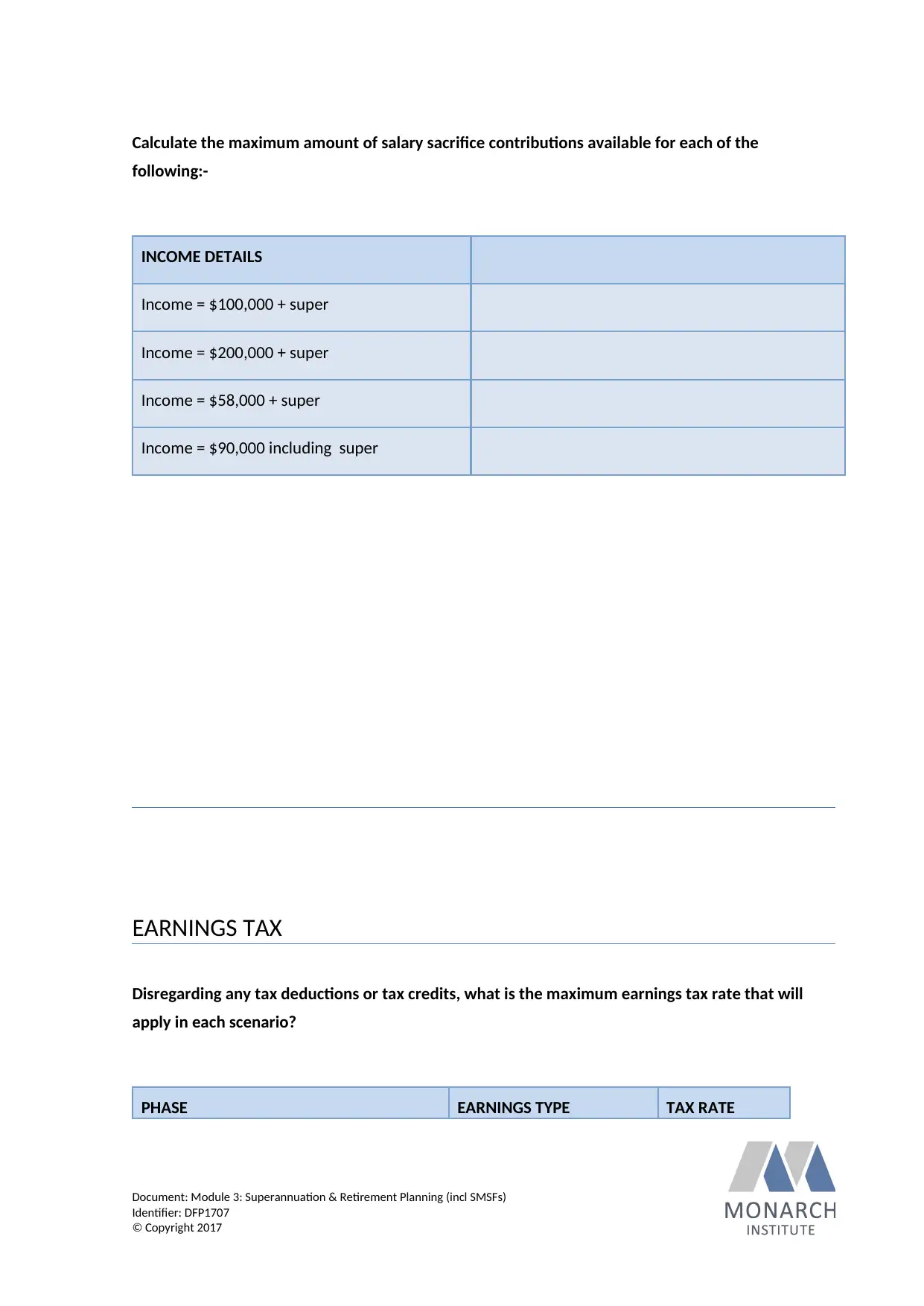
Calculate the maximum amount of salary sacrifice contributions available for each of the
following:-
INCOME DETAILS
Income = $100,000 + super
Income = $200,000 + super
Income = $58,000 + super
Income = $90,000 including super
EARNINGS TAX
Disregarding any tax deductions or tax credits, what is the maximum earnings tax rate that will
apply in each scenario?
PHASE EARNINGS TYPE TAX RATE
Document: Module 3: Superannuation & Retirement Planning (incl SMSFs)
Identifier: DFP1707
© Copyright 2017
following:-
INCOME DETAILS
Income = $100,000 + super
Income = $200,000 + super
Income = $58,000 + super
Income = $90,000 including super
EARNINGS TAX
Disregarding any tax deductions or tax credits, what is the maximum earnings tax rate that will
apply in each scenario?
PHASE EARNINGS TYPE TAX RATE
Document: Module 3: Superannuation & Retirement Planning (incl SMSFs)
Identifier: DFP1707
© Copyright 2017
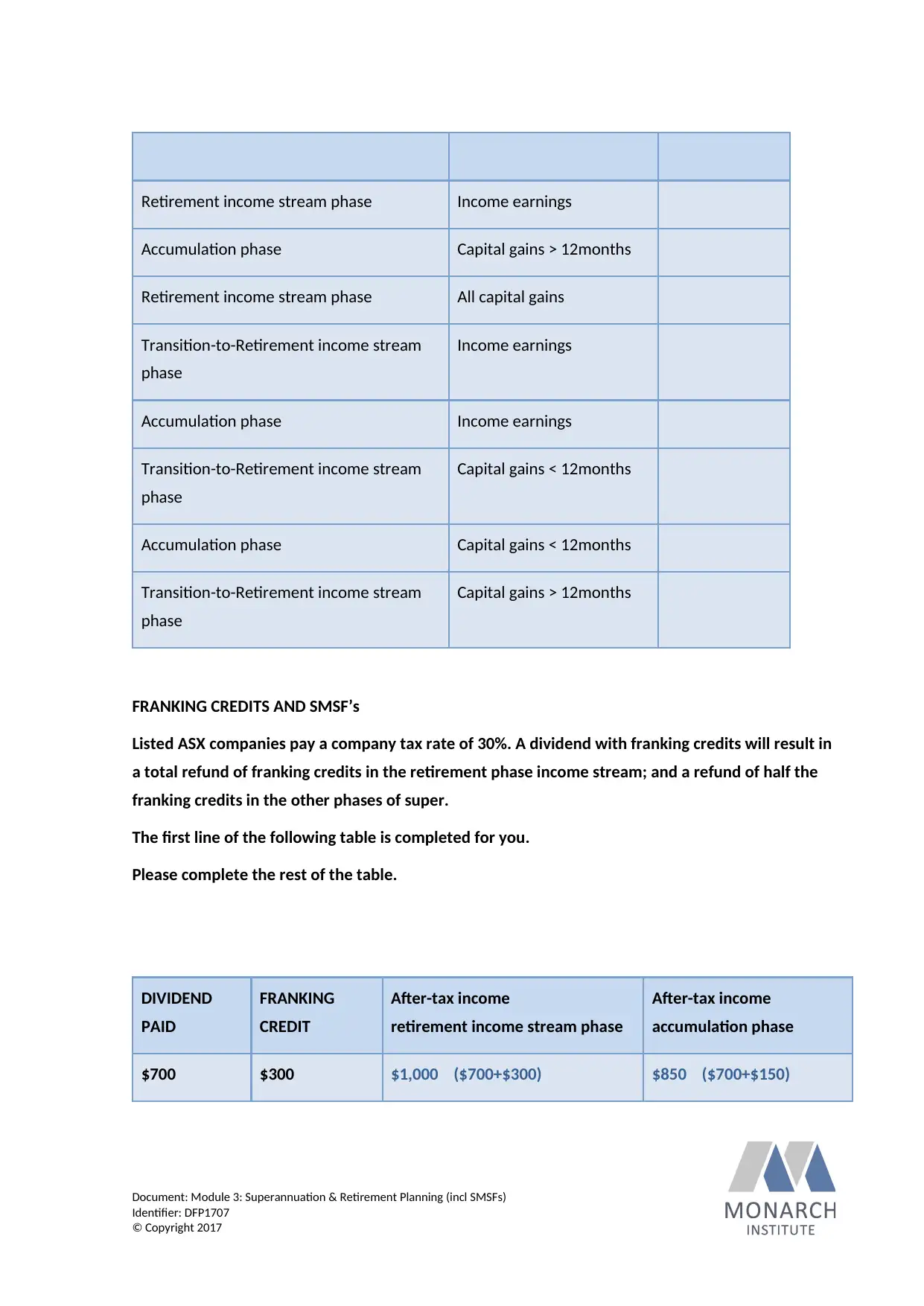
Retirement income stream phase Income earnings
Accumulation phase Capital gains > 12months
Retirement income stream phase All capital gains
Transition-to-Retirement income stream
phase
Income earnings
Accumulation phase Income earnings
Transition-to-Retirement income stream
phase
Capital gains < 12months
Accumulation phase Capital gains < 12months
Transition-to-Retirement income stream
phase
Capital gains > 12months
FRANKING CREDITS AND SMSF’s
Listed ASX companies pay a company tax rate of 30%. A dividend with franking credits will result in
a total refund of franking credits in the retirement phase income stream; and a refund of half the
franking credits in the other phases of super.
The first line of the following table is completed for you.
Please complete the rest of the table.
DIVIDEND
PAID
FRANKING
CREDIT
After-tax income
retirement income stream phase
After-tax income
accumulation phase
$700 $300 $1,000 ($700+$300) $850 ($700+$150)
Document: Module 3: Superannuation & Retirement Planning (incl SMSFs)
Identifier: DFP1707
© Copyright 2017
Accumulation phase Capital gains > 12months
Retirement income stream phase All capital gains
Transition-to-Retirement income stream
phase
Income earnings
Accumulation phase Income earnings
Transition-to-Retirement income stream
phase
Capital gains < 12months
Accumulation phase Capital gains < 12months
Transition-to-Retirement income stream
phase
Capital gains > 12months
FRANKING CREDITS AND SMSF’s
Listed ASX companies pay a company tax rate of 30%. A dividend with franking credits will result in
a total refund of franking credits in the retirement phase income stream; and a refund of half the
franking credits in the other phases of super.
The first line of the following table is completed for you.
Please complete the rest of the table.
DIVIDEND
PAID
FRANKING
CREDIT
After-tax income
retirement income stream phase
After-tax income
accumulation phase
$700 $300 $1,000 ($700+$300) $850 ($700+$150)
Document: Module 3: Superannuation & Retirement Planning (incl SMSFs)
Identifier: DFP1707
© Copyright 2017
⊘ This is a preview!⊘
Do you want full access?
Subscribe today to unlock all pages.

Trusted by 1+ million students worldwide
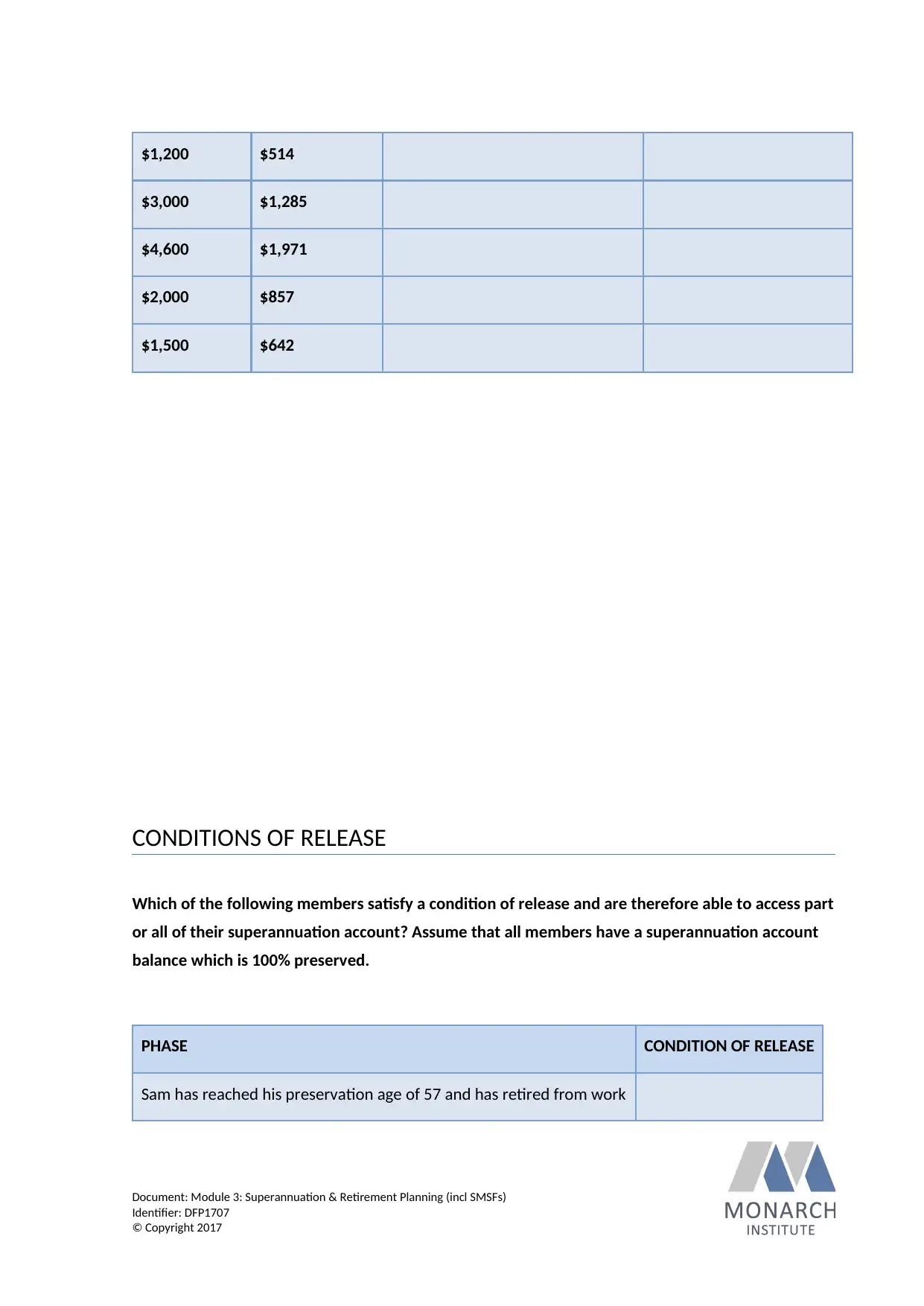
$1,200 $514
$3,000 $1,285
$4,600 $1,971
$2,000 $857
$1,500 $642
CONDITIONS OF RELEASE
Which of the following members satisfy a condition of release and are therefore able to access part
or all of their superannuation account? Assume that all members have a superannuation account
balance which is 100% preserved.
PHASE CONDITION OF RELEASE
Sam has reached his preservation age of 57 and has retired from work
Document: Module 3: Superannuation & Retirement Planning (incl SMSFs)
Identifier: DFP1707
© Copyright 2017
$3,000 $1,285
$4,600 $1,971
$2,000 $857
$1,500 $642
CONDITIONS OF RELEASE
Which of the following members satisfy a condition of release and are therefore able to access part
or all of their superannuation account? Assume that all members have a superannuation account
balance which is 100% preserved.
PHASE CONDITION OF RELEASE
Sam has reached his preservation age of 57 and has retired from work
Document: Module 3: Superannuation & Retirement Planning (incl SMSFs)
Identifier: DFP1707
© Copyright 2017
Paraphrase This Document
Need a fresh take? Get an instant paraphrase of this document with our AI Paraphraser
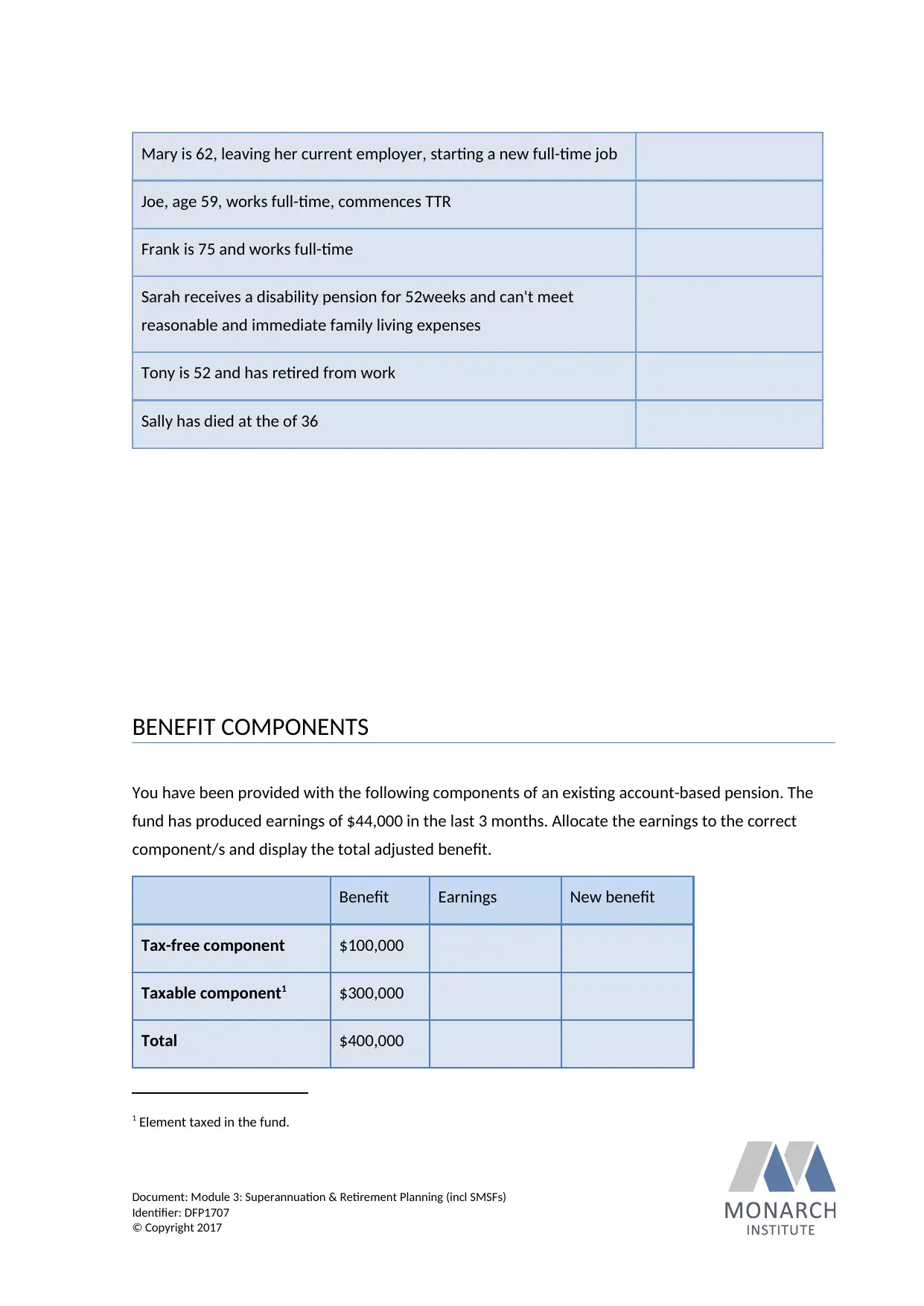
Mary is 62, leaving her current employer, starting a new full-time job
Joe, age 59, works full-time, commences TTR
Frank is 75 and works full-time
Sarah receives a disability pension for 52weeks and can't meet
reasonable and immediate family living expenses
Tony is 52 and has retired from work
Sally has died at the of 36
BENEFIT COMPONENTS
You have been provided with the following components of an existing account-based pension. The
fund has produced earnings of $44,000 in the last 3 months. Allocate the earnings to the correct
component/s and display the total adjusted benefit.
Benefit Earnings New benefit
Tax-free component $100,000
Taxable component1 $300,000
Total $400,000
1 Element taxed in the fund.
Document: Module 3: Superannuation & Retirement Planning (incl SMSFs)
Identifier: DFP1707
© Copyright 2017
Joe, age 59, works full-time, commences TTR
Frank is 75 and works full-time
Sarah receives a disability pension for 52weeks and can't meet
reasonable and immediate family living expenses
Tony is 52 and has retired from work
Sally has died at the of 36
BENEFIT COMPONENTS
You have been provided with the following components of an existing account-based pension. The
fund has produced earnings of $44,000 in the last 3 months. Allocate the earnings to the correct
component/s and display the total adjusted benefit.
Benefit Earnings New benefit
Tax-free component $100,000
Taxable component1 $300,000
Total $400,000
1 Element taxed in the fund.
Document: Module 3: Superannuation & Retirement Planning (incl SMSFs)
Identifier: DFP1707
© Copyright 2017
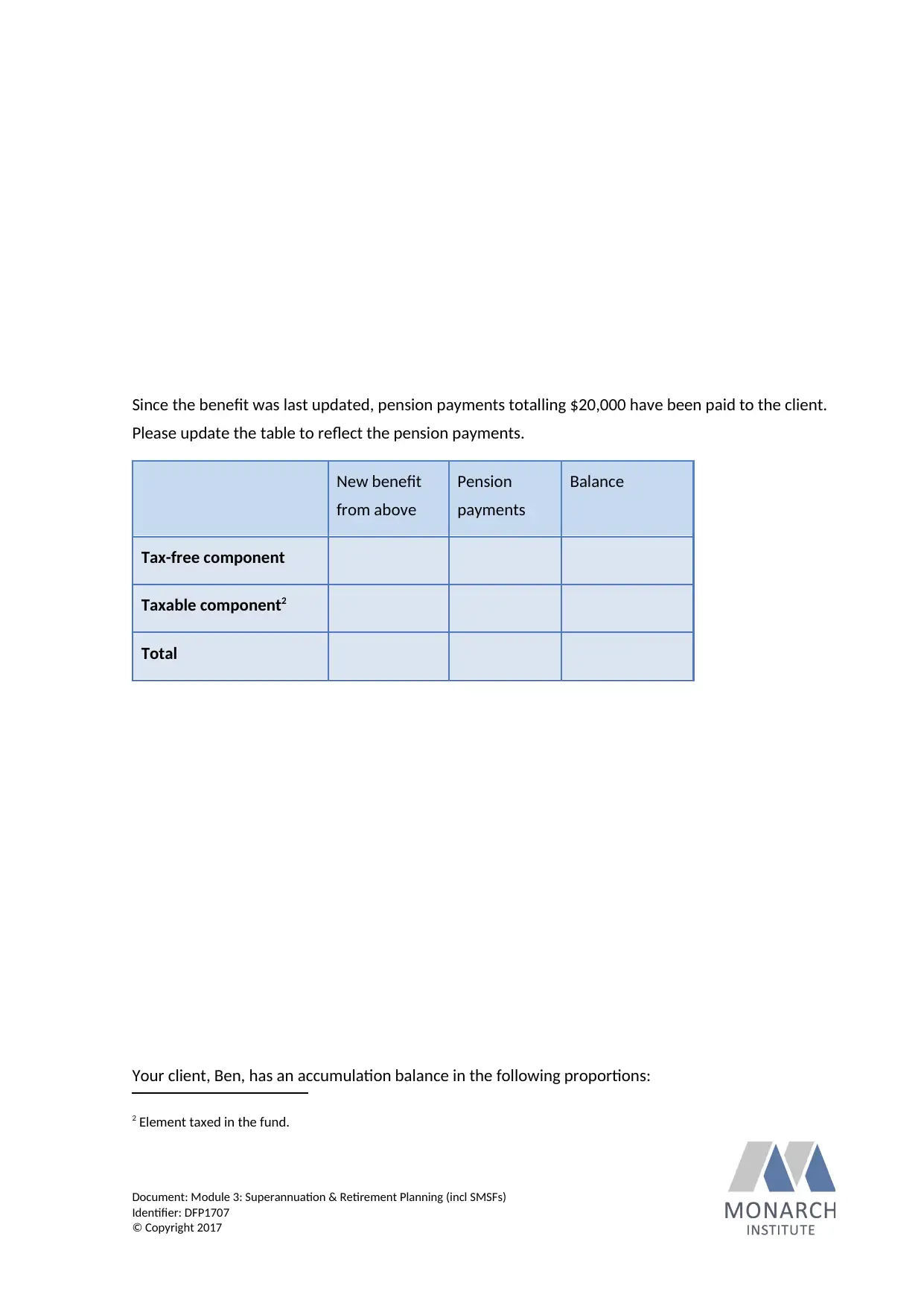
Since the benefit was last updated, pension payments totalling $20,000 have been paid to the client.
Please update the table to reflect the pension payments.
New benefit
from above
Pension
payments
Balance
Tax-free component
Taxable component2
Total
Your client, Ben, has an accumulation balance in the following proportions:
2 Element taxed in the fund.
Document: Module 3: Superannuation & Retirement Planning (incl SMSFs)
Identifier: DFP1707
© Copyright 2017
Please update the table to reflect the pension payments.
New benefit
from above
Pension
payments
Balance
Tax-free component
Taxable component2
Total
Your client, Ben, has an accumulation balance in the following proportions:
2 Element taxed in the fund.
Document: Module 3: Superannuation & Retirement Planning (incl SMSFs)
Identifier: DFP1707
© Copyright 2017
⊘ This is a preview!⊘
Do you want full access?
Subscribe today to unlock all pages.

Trusted by 1+ million students worldwide
1 out of 45
Your All-in-One AI-Powered Toolkit for Academic Success.
+13062052269
info@desklib.com
Available 24*7 on WhatsApp / Email
![[object Object]](/_next/static/media/star-bottom.7253800d.svg)
Unlock your academic potential
Copyright © 2020–2025 A2Z Services. All Rights Reserved. Developed and managed by ZUCOL.
